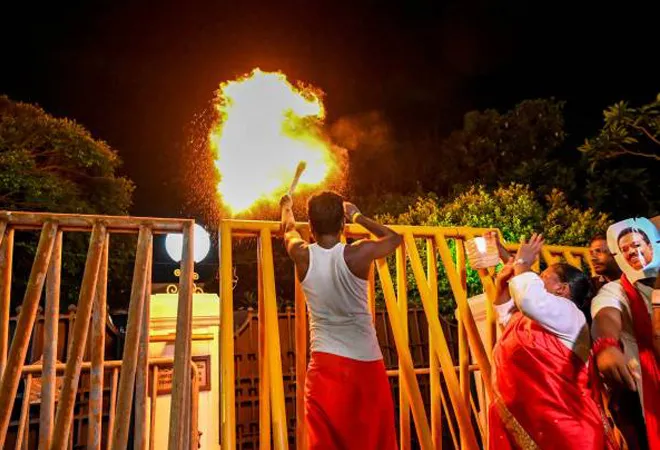
As Sri Lanka descends further into chaos, the responses from the world have been rather limited. India is playing a crucial role in assisting the island state, China is cautiously responding to the crisis, whereas the West is playing a minimalist role in Sri Lanka’s economic recovery. Broadly, these varied responses are reflecting how these stakeholders are visualising and positioning themselves in the new world order that is gravitating towards the Indo-Pacific.
Anchoring its influence in the Indo-Pacific
As the world has come to terms with the growing prominence of the Indo-Pacific, India too has adopted and accommodated its neighbourhood and the Indian Ocean policies within its Indo-Pacific strategy. For India, the Indo-Pacific strategy is important to enhance its influence, be a net security provider, limit Chinese expansion and threats in the Indian Ocean, and display its maritime capabilities.
In fact, these calculations have driven New Delhi’s policy vis-à-vis the crisis-hit Sri Lanka. In recent times, Beijing’s presence and projects in Sri Lanka had left India uncomfortable. However, as the tussle over the fertiliser issue between Sri Lanka and China intensified, India found an opportunity to re-entrench its influence in the island state. Starting from January this year, India has committed more than
US $3 billion to Sri Lanka (Refer Table 1). This includes a US $1-billion credit line for essential commodities, a US $500-million credit line for the purchase of petroleum products, US $400 million for a currency swap, and US $1billion for the Asian Clearing Union Framework.
Geoeconomic investments in strategic sectors and locations, and India’s role as a net-security provider have also taken the lead in this strategy. India has not only managed to compel Sri Lanka to cancel some Chinese projects but has also offered new investments in the country. This includes
the modernisation and development of projects related to energy security (both renewable and non-renewable), logistics, connectivity, infrastructure, and ports. Similarly, India has also attempted to counter traditional and non-traditional threats by institutionalising the Colombo Security Conclave and
also offering Sri Lanka a Free-Floating Dock Facility, Maritime Rescue Co-ordination Centre, and Dornier Reconnaissance aircraft.
India has not only managed to compel Sri Lanka to cancel some Chinese projects but has also offered new investments in the country.
India’s response to the crisis has been proactive and holistic. This significant display of its material, economic, and diplomatic capabilities are indicating its vision of a multipolar world where India would be playing a critical role in the new world order and the Indo-Pacific.
Table 1: Sri Lanka’s financial assistance in 2022
| Country/organisation |
Total financial aid in US$ (2022) |
Additional assistance (requested or under negotiations) in US$ |
| India |
3 billion |
1.5 billion |
| China |
76 million |
2.5 billion |
| IMF |
- |
4 billion |
| World Bank |
- |
300–600 million |
Source: Author’s compilation
China’s reassessment:
On the other hand, China’s approach to the crisis has been cautious and underwhelming. Sri Lanka and China have enjoyed a significant bonhomie for decades. As the final phase of the Sri Lankan civil war ended, the island state found a
new friend in China—considering the latter’s indifference to Sri Lanka’s human rights situation and unsustainable borrowing. China still remains Sri Lanka’s largest donor with a US $6.5-billion
lending.
With these economic and political stakes, China
helped Colombo with a US $1-billion loan and a currency swap deal of US $1.5 billion in 2020. This assistance has
pretty much waned since their tussle over the fertiliser issue and Sri Lanka’s unilateral cancellation of the Chinese projects in the Northern provinces (refer Table 1). Ever since China has offered a token assistance worth US $
76 million. This is despite Sri Lanka’s request for loan restructuring and additional financial support of US $
2.5 billion.
Beijing has also tried to leverage the crisis and has been very calculative in its approach. For instance, China has been attempting to expedite a
Free Trade Agreement with Sri Lanka by leveraging the former’s request for loan restructuring. It also
seems that Beijing was attempting to use this opportunity to offer distinct bilateral assistance to Sri Lanka and deter the latter from approaching the International Monetary Fund (IMF). Its
initial displeasure with the negotiations between Sri Lanka and IMF further substantiates this argument. Yet, China soon
reversed its position and registered support for the ongoing negotiations.
China has been attempting to expedite a Free Trade Agreement with Sri Lanka by leveraging the former’s request for loan restructuring.
This slow, cautious, and calculative response is likely due to a recalculation in China’s Indian Ocean strategy—which had been first reconsidered
in the Maldives, and now in Sri Lanka. Primarily, it seems that China’s tactic of
elite capture, which had worked well against India for some time is now under strain due to a government change in the Maldives and the Rajapaksas’ balancing game due to domestic compulsions.
Secondly, the Sri Lankan crisis has also begun to expose the sheer dangers of unsustainable borrowing for the rest of the world. Having lent money with grand ambitions, China does not want to set the
precedent for fresh requests for loan restructuring, especially at a time when COVID-19 has significantly impacted several small economies. In this context, Sri Lanka’s unilateral decision to suspend all its
foreign debt repayments might have also triggered some alarm bells for Beijing. Perhaps this also explains China’s recent U-turn on Sri Lanka’s negotiations with the IMF.
Sri Lanka continues to be crucial for China’s Belt Road Initiative (BRI) and influence in the Indian Ocean. Although China is currently observing and re-calculating its future course, it is also trying not to completely alienate and push Sri Lanka towards India and the West. China has thus continued to respond to the crisis, slowly and passively, despite some diplomatic setbacks and disappointments.
Although China is currently observing and re-calculating its future course, it is also trying not to completely alienate and push Sri Lanka towards India and the West.
The West: Yet to move beyond rhetoric
The West’s response has been minimal, despite maintaining that Chinese loans are
a challenge to its “value-based order”. But there also seems to be a lack of understanding of the broader conception and approaches toward the Indo-Pacific. Pre-occupied with the withdrawal in Afghanistan and the war in Ukraine, the EU seems very less interested in the ongoing crisis. Even the latest joint commission meeting held between the EU and Sri Lanka in
February 2022 had no mention of the brewing crisis, and the focus was rather on human rights, democracy, sectoral cooperation, trade, etc.
On the other hand, while the US has shown some interest in Sri Lanka, it is yet to walk the talk. The US has welcomed Sri Lanka’s decision to work with the IMF and debt sustainability, despite the
differences that surfaced with the Rajapaksas’ pro-China stance. It has also requested its other QUAD and western partners to help Sri Lanka
diversify its sources of credit and investment. But this is not a new proposal. The West and its partners continue to face issues to provide an institutionalised alternative to the Chinese Belt Road Initiative. In fact, several proposed initiatives such as Asia-Africa Growth Corridor and the Build Back Better World (B3W) have been underutilised or left in cold storage.
The US has welcomed Sri Lanka’s decision to work with the IMF and debt sustainability, despite the differences that surfaced with the Rajapaksas’ pro-China stance.
The West is yet to have some broader consensus over their Indo-Pacific strategy. While the US’s foreign policy has been relatively realistic, the rest of the EU continues to stress on norms and values. The lack of a mutual approach again leaves India to do most of the material and value-based weightlifting in the region. This has already grown clear with India’s
consistent bilateral support and push for Sri Lanka to negotiate with the IMF. Now with Sri Lanka finally approaching the IMF and the World Bank (refer Table 1), the West has also been granted another opportunity to prove its material and institutional relevance in the new world order; and this calls for a more unified and robust response than what is currently being offered.
Overall, the response to the Sri Lankan economic crisis has differed widely and based on how the stakeholders are visualising their broader Indo-Pacific strategy. As the world continues to come to terms with the growing significance of the Indo-Pacific, major powers will formulate and moderate their policies to stay relevant and influential in the region. In this context, the responses to the Sri Lankan crisis are and will be a mere reflection of the global players’ priorities, and their strengths and weaknesses in the Indo-Pacific.
The views expressed above belong to the author(s). ORF research and analyses now available on Telegram! Click here to access our curated content — blogs, longforms and interviews.



 As Sri Lanka descends further into chaos, the responses from the world have been rather limited. India is playing a crucial role in assisting the island state, China is cautiously responding to the crisis, whereas the West is playing a minimalist role in Sri Lanka’s economic recovery. Broadly, these varied responses are reflecting how these stakeholders are visualising and positioning themselves in the new world order that is gravitating towards the Indo-Pacific.
As Sri Lanka descends further into chaos, the responses from the world have been rather limited. India is playing a crucial role in assisting the island state, China is cautiously responding to the crisis, whereas the West is playing a minimalist role in Sri Lanka’s economic recovery. Broadly, these varied responses are reflecting how these stakeholders are visualising and positioning themselves in the new world order that is gravitating towards the Indo-Pacific.
 PREV
PREV


